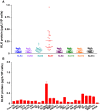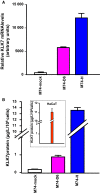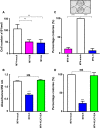Aberrant expression of kallikrein-related peptidase 7 is correlated with human melanoma aggressiveness by stimulating cell migration and invasion
- PMID: 28636767
- PMCID: PMC5623816
- DOI: 10.1002/1878-0261.12103
Aberrant expression of kallikrein-related peptidase 7 is correlated with human melanoma aggressiveness by stimulating cell migration and invasion
Abstract
Members of the tissue kallikrein-related peptidase (KLK) family not only regulate several important physiological functions, but aberrant expression has also been associated with various malignancies. Clinically, KLKs have been suggested as promising biomarkers for diagnosis and prognosis in many types of cancer. As of yet, expression of KLKs and their role in skin cancers are, however, poorly addressed. Malignant melanoma is an aggressive disease associated with poor prognosis. Hence, diagnostic biomarkers to monitor melanoma progression are needed. Herein, we demonstrate that although mRNA of several KLKs are aberrantly expressed in melanoma cell lines, only the KLK7 protein is highly secreted in vitro. In line with these findings, ectopic expression of KLK7 in human melanomas and its absence in benign nevi were demonstrated by immunohistochemistry in vivo. Interestingly, overexpression of KLK7 induced a significant reduction in melanoma cell proliferation and colony formation. Moreover, KLK7 overexpression triggered an increase in cell motility and invasion associated with decreased expression of E-cadherin and an upregulation of MCAM/CD146. Our results demonstrate, for the first time, that aberrant KLK7 expression leads to a switch from proliferative to invasive phenotype, suggesting a potential role of KLK7 in melanoma progression. Thus, we hypothesize that KLK7 may represent a potential biomarker for melanoma progression.
Keywords: E-cadherin; invasion; kallikrein-related peptidase 7; melanoma; migration; proliferation.
© 2017 The Authors. Published by FEBS Press and John Wiley & Sons Ltd.
Figures








Similar articles
-
Kallikrein-related peptidase 7 overexpression in melanoma cells modulates cell adhesion leading to a malignant phenotype.Biol Chem. 2018 Sep 25;399(9):1099-1105. doi: 10.1515/hsz-2017-0339. Biol Chem. 2018. PMID: 29498930
-
Kallikrein-related peptidase 7 (KLK7) is a proliferative factor that is aberrantly expressed in human colon cancer.Biol Chem. 2014 Sep;395(9):1075-86. doi: 10.1515/hsz-2014-0142. Biol Chem. 2014. PMID: 25153388
-
Clinical significance of kallikrein-related peptidase 7 (KLK7) in colorectal cancer.Thromb Haemost. 2009 Apr;101(4):741-7. Thromb Haemost. 2009. PMID: 19350120
-
The kallikrein-related peptidase family: Dysregulation and functions during cancer progression.Biochimie. 2016 Mar;122:283-99. doi: 10.1016/j.biochi.2015.09.002. Epub 2015 Sep 4. Biochimie. 2016. PMID: 26343558 Review.
-
Molecular networks in melanoma invasion and metastasis.Future Oncol. 2013 May;9(5):713-26. doi: 10.2217/fon.13.9. Future Oncol. 2013. PMID: 23647299 Review.
Cited by
-
Remodelling of the tumour microenvironment by the kallikrein-related peptidases.Nat Rev Cancer. 2022 Apr;22(4):223-238. doi: 10.1038/s41568-021-00436-z. Epub 2022 Jan 31. Nat Rev Cancer. 2022. PMID: 35102281 Review.
-
Bioinformatic analysis identifies epidermal development genes that contribute to melanoma progression.Med Oncol. 2022 Jul 14;39(10):141. doi: 10.1007/s12032-022-01734-8. Med Oncol. 2022. PMID: 35834068
-
WIPI1, BAG1, and PEX3 Autophagy-Related Genes Are Relevant Melanoma Markers.Oxid Med Cell Longev. 2018 Dec 2;2018:1471682. doi: 10.1155/2018/1471682. eCollection 2018. Oxid Med Cell Longev. 2018. PMID: 30622661 Free PMC article.
-
Recombinant scFv-Fc Anti-kallikrein 7 Antibody-Loaded Thermosensitive Hydrogels Against Skin Desquamation Disorders.ACS Appl Bio Mater. 2024 Jul 15;7(7):4486-4496. doi: 10.1021/acsabm.4c00371. Epub 2024 Jun 17. ACS Appl Bio Mater. 2024. PMID: 38886921 Free PMC article.
-
The environmental carcinogen benzo[a]pyrene regulates epigenetic reprogramming and metabolic rewiring in a two-stage mouse skin carcinogenesis model.Carcinogenesis. 2023 Aug 10;44(5):436-449. doi: 10.1093/carcin/bgad024. Carcinogenesis. 2023. PMID: 37100755 Free PMC article.
References
-
- French Public Health Code: Bioethical Law 2004‐800 of August 6, 2004 on bioethics. Journal official 182, Art. L. 1232‐1, Art. L. 1235‐2, Art. L. 1245‐2.
-
- Borgono CA and Diamandis EP (2004) The emerging roles of human tissue kallikreins in cancer. Nat Rev Cancer 4, 876–890. - PubMed
-
- Caubet C, Jonca N, Brattsand M, Guerrin M, Bernard D, Schmidt R, Egelrud T, Simon M, Serre G (2004) Degradation of corneodesmosome proteins by two serine proteases of the kallikrein family, SCTE/KLK5/hK5 and SCCE/KLK7/hK7. J Invest Dermatol. 122, 1235–1244. - PubMed
-
- Chung H, Hamza M, Oikonomopoulou K, Gratio V, Saifeddine M, Virca GD, Diamandis EP, Hollenberg MD, Darmoul D (2012) Kallikrein‐related peptidase signaling in colon carcinoma cells: targeting proteinase‐activated receptors. Biol Chem 393, 413–420. - PubMed
Publication types
MeSH terms
Substances
LinkOut - more resources
Full Text Sources
Other Literature Sources
Medical
Research Materials

